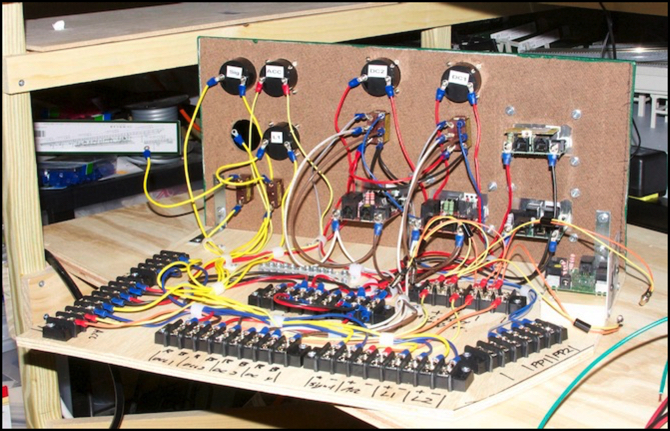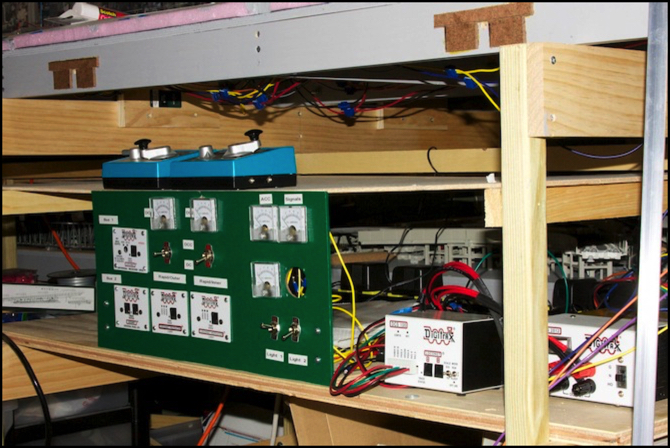Scotty I Need More Power!
25 July 2010 00:12 Filed in: Electrical,Electronics

DCC doesn’t need to be complicated. At the simplest, it’s a pair of bus wires from the command station running under the track, with feeders connecting the track to it at intervals. I can, however, make anything complicated. Probably more complicated than it needs to be. It’s a talent.
After a short-lived initial plan of using my existing Zephyr foundered on the fact that it puts out 2.5 Amps of DCC, which is perhaps enough for five trains I decided I needed more power. Even assuming one train per track it was clear that 2.5 Amps wasn’t enough, as I have six tracks. And one of the reasons for doing DCC (rather than six power packs) is to run more than one train per track. So the first thing I did was buy a DCS100 Command Station, which puts out 5 amps, and needs a beefy power supply. So I bought a PS2012. The PS2012 is effectively four, five-amp power supplies when operating at 13.8 volts (the “N scale” setting). One connects to the command station, and a second is reserved for a booster in case I needed one.
This left me with two extra power supplies. I decided to use one for accessories (mostly DS64 stationary decoders to throw switches) and one for the signaling accessories (non-track power for the PM42 Circuit Breakers, BDL168 Track Occupancy Detectors, and SE8C Signal Controller. Both of those could comfortably fit on one 5 Amp supply, but I’m going to keep them separate to avoid any electrical noise issues from the DS64s, which likely generate sharp transients on the power line when throwing a switch. If I ever need to use a third supply for a second booster (perhaps once the storage tracks are built), I can re-arrange things then.
On top of all that, I wanted to light buildings, train station platforms, and streetlights with LEDs for “nighttime” operations, and so I needed a supply for that. I could have used the accessory supply, but it puts out 13.8 volts, and I knew I’d find that confusing. Plus I like having the lighting independent, as I’m more likely to make a wiring mistake there, and I’d rather not risk frying a $60 DS64 when (not if) I do. So I bought a couple of regulated 12 volt, 1.5 Amp “wall wart” supplies (similar to the PS14, but larger). These will supply separate lighting to the Riverside Station and Urban Station scenes (I’ll likely add a third for the River Crossing scene eventually).
Now I needed a place to put the LNRP panels I was using to subdivide my LocoNet control bus; there are enough devices on it that I’m past the “20” mark where Digitrax recommends subdividing it) and the UR92 panel that provides the receiver for my DT402D wireless throttles. Plus I needed some panel, either one of those or a simple UP5, to provide a power supply to the wireless throttles when the layout was not in use. I went with the UP5, as I have a number of those I can recycle from the old HO layout.
Additionally, I want to make the two tracks of the outer (Rapid/Shinkansen) loop switchable from DCC to DC, to allow breaking in new trains before conversion, and running any trains that never get converted to DCC, I needed some place to put the DPDT on-off-on switches for that, as well as some way to indicate if the track was running DC or DCC (the light on a Digitrax fascia panel can do that; it lights red or green for DC, and orange for DCC).
And, because I like to see what’s going on, I wanted Ammeters on each of the six power supplies (DCC Command Station, future DCC Booster, Accessories, Signaling, Lighting 1 and Lighting 2). So I took a spare sheet of hardboard left over from making the backdrops, attached it to a piece of scrap plywood, cut some holes in it, painted the front, and did one heck of a lot of wiring (as you can see up above).

The end result (not quite done; I’m short one Ammeter) ended up looking pretty good. Hopefully it won’t go up in smoke the first time I apply power. I tested each set of wires for resistance with my multimeter as I installed them, so it should be okay.
Another result of all these supplies is that there are seven pairs of bus wires under each table (DCC1, DCC2, DC/DCC3, DC/DCC4, Accessory, Signal, and Lighting). I’d only installed three originally, so I’ve been adding more bus wiring as I went (still only about half done with the new stuff). As I do, I’m moving the two subway tracks over to the switched DC/DCC buses, so I’ll be able to run either kind of train prior to finishing the outer loop (which will ultimately be the one on the switched busses).
It’s all an annoying amount of work, and it’s delayed me getting to the foam topography of the Riverside station for several weeks. But after the time I had doing the original bus wiring when I activated the subway track, I want this task done before I get the two upper-level loops (Rapid and Commuter) finished, as I don’t want a two week delay in running a train once I’m ready.
And there’s that nagging voice that says I’m gilding the lilly here, and could have gotten away with much less. It’s annoying because it’s true, and yet having this will keep me from worrying that my power supplies are overloaded (or seeing if they are), and will give me the flexibility to add a booster (or two) in the future, if my 5 Amp command station turns out to be too small.
The “phase 2h” Construction page and Wiring Design pages, as well as the Construction photo album, have all been updated (mostly with the same info as here).
Other website updates:
- It’s been a busy month for new trains, and the Roster page and Roster photo album have been updated to list them.
- First, my long-awaited Chūō-Sōbu E231-0 arrived. It’s been on pre-order reservation since February. This is Micro Ace’s model of the late-model version, with a slightly different “skirt” on the cab, but more significantly the first car bears the pink “women only” stickers now found on this car, marking it as a more contemporary model. Dedicated cars for women are one of the ways JR deals with the extreme overcrowding of rush-hour trains in Tōkyō, and the high incidence of groping female commuters have to put up with (it’s hard to identify offenders with there are a dozen people within reach, and everyone’s packed together).
- Second, my Izukyū “Black Ships Train” arrived. The Izu Kyūkō Line is a private railroad on the Izu peninsula (to the southwest of Tōkyō), but these trains operate into Tōkyō Station at the height of the tourist season. The train is a glossy black version of the 2100 series trains used to carry day-trippers and vacationers to this area, and commemorates the landing of Commodore Perry’s “Black Ships” (Shimoda, the end station of the present Izu Kyūkō Line, was the site of a U.S. consulate established after Perry made contact with the Japanese government in 1853). Several photos of this posed on the layout have been added to the Roster photo album.
- And finally, although I don’t have any locomotive-hauled passenger cars (yet), I broke down and bought one of Kato’s JR East EF510-500 “Northern Star” locomotives (the blue paint scheme with the shooting star on the side). I decided I’d rather get it now and have it sit on a shelf, than discover it was out of stock when I later get some passenger cars. The passenger cars will be the problem, as the ones I want (Kato’s Hokutosei sleeper set) are mostly out of stock, but at the May Shizuoka Hobby Show, Kato apparently announced they were planning on doing a version of the current train (their previous/current model had, I think, been an earlier version). There’s no announced date for it yet, but I’m going to preorder it when there is. In preparation I’ve added a page to my prototype trains section on “Resort and Other Passenger Trains”, which will include information these as well as resort trains like the “Black Ships Train”. There’s a matching page in the Roster section.
== Comments from old system
Sunday, July 25, 2010 - 09:01 AM
Don
Actually, this looks quite good! You've done a great job keeping everything neat and tidy, and I think that this is one case where over-engineering is definitely going to pay dividends a few years hence. Plus, when you decide to scrap this layout and make a new one (!!) you've got a nice distribution panel all ready to go :D
BTW, if you worry this is yak-shaving…you should see what I've been doing. Since I'm a few years off from needing anything, and after deciding there's nothing on the market that works for me (except maybe Digitrax, but that it's just so expensive), I've actually begun designing my own line of DCC equipment. The 3A and 6A booster designs are nearly complete, but I probably won't get around to building one for a couple of years.
FYI, the recent Kato Hokutosei release was based on the 1989 (first year post JNR) JRE consist. The recent Tomix release was based on a recent JRH consist (JRE and JRH jointly maintain a fleet of Hokutosei sets).
Sunday, July 25, 2010 - 11:54 AM
KenS
Don, thanks for the info. I have followed your posting about the DCC equipment you're thinking of designing (I read Akihabara Station, I just don't comment since it requires registration and I'm incredibly lazy).
I'd thought that was how the Hokutosei models were, although I'll note that the Japanese Wikipedia Hokutosei page (北斗星 (列車)) says the current set is a mix of 6 JRE and 6 JRH cars (1-6 and 7-12, respectively).
I'm really interested to see what this supposed new Kato model will look like. One sentence in the show coverage wasn't enough to be sure it isn't just a reissue, although it makes sense to issue a new one that matches the EF510-500.
BTW, I just fixed some problems with a couple of images on the prototype Resort and Other Passenger Trains page, and took the opportunity to update some of the info there from closer reading of the translated Japanese pages.




